Boosting real-world listening performance with Signia AX: A first glimpse at data from an international survey
Niels Søgaard Jensen, Leanne Powers, Erik Harry Høydal
Introduction
Signia has a long track record of developing innovative products that optimize performance in all types of listening situations that are important to the individual wearer. The goal of optimizing wearer performance across a range of divergent listening conditions was a main driver in the development of the Signia Augmented Xperience (AX) platform with the revolutionary Augmented Focus™ technology.
The ability of Augmented Focus to optimize the contrast between speech, which the wearer typically wants to follow and understand, and background sounds the wearer simply wants to be aware of, affects the entire listening experience. Signia AX with Augmented Focus specifically addresses the challenge of understanding speech in background noise, which is still one of the most dominant complaints made by wearers of hearing aids (Picou, 2020).
Given these unique features, Augmented Focus provides strong perceptual benefits for the wearer in a variety of listening situations in everyday life. While wearer benefits may be demonstrated using lab measures, generated under controlled test conditions, the preferred way to explore the full potential of Augmented Focus is to fit Signia AX to wearers and ask them to use it in real world listening situations. Toward that objective, an international survey was conducted in the United States, Germany and France.
The survey included a comparison of Signia AX and the respondents’ own hearing aids, based on their own daily life experiences. The wearers’ experience with the devices were assessed via questionnaires that assessed various types of listening situations in which Augmented Focus is believed to provide a substantial improvement over the wearers’ current hearing aids.
Because the survey was conducted during the COVID-19 pandemic, it provided some obvious challenges. Some types of situations were rarely – or not at all – encountered during daily life due to local social distancing guidelines. However, the survey respondents continued to lead their daily lives in a variety of auditory surroundings, and the fundamental listening challenges caused by their hearing loss were still present.
The first tranche of data from the survey offer some intriguing insights into how these listening challenges were addressed by Signia AX. Although survey data collection is ongoing, this white paper presents preliminary data from the US portion of the survey. Even though it is not the final data, these early data provide some clear indications of the performance and benefits of Signia AX and Augmented Focus in real world listening conditions.
Augmented Focus™
Before reviewing survey findings, let’s look at Augmented Focus, a new and fundamentally different approach to sound processing in a hearing aid. The basic underlying concept of Augmented Focus is to improve the wearer’s access to speech by increasing the contrast between speech and other sounds surrounding the wearer. It is believed increasing the contrast between speech and surrounding sounds supports the brain in performing auditory scene analysis (Bregman, 1990). By helping the brain separate divergent sound streams from each other, Augmented Focus makes it easier for the listener to differentiate between speech and background noises. If, for example, a speech stream is separated from a stream of background noise, it will improve the listener’s ability to understand the speech. In contrast, if the two streams are not separated, they will be perceived by the listener as a single mixed stream of sound, which greatly reduces the probability the listener will understand speech in the presence of noise.
The main principles of Augmented Focus are illustrated in Figure 1. An important foundation of Augmented Focus is Signia’s unique beamformer technology, which is used to split the incoming sound into two separate signal streams. One stream contains sounds coming from the front of the wearer, while the other stream contains sounds arriving from the wearer’s back and sides.
Augmented Focus uses a dedicated processor to analyze the characteristics of the sounds in each stream. To optimally address the listening needs of the wearer, one stream is processed independently from the other stream across 48 channels. This unique split processing approach allows one stream to be processed as a Focus stream where the aim of the processing is to optimize speech clarity and intelligibility. In contrast, the other stream is processed – completely differently – as a Surrounding stream in which the aim is twofold: 1) Provide clear and stable amplification of the wearer’s soundscape, and 2) Introduce a large contrast between the Focus stream, which is usually sounds coming from the front of the wearer, and the Surrounding stream, often sounds coming from the back and sides. The latter rationale typically provides more compression and a more powerful noise reduction for sound coming from the back and sides. In the example shown in the Figure 1, the Focus area is in front of the wearer, but the Focus area could be in any direction relative to the wearer.
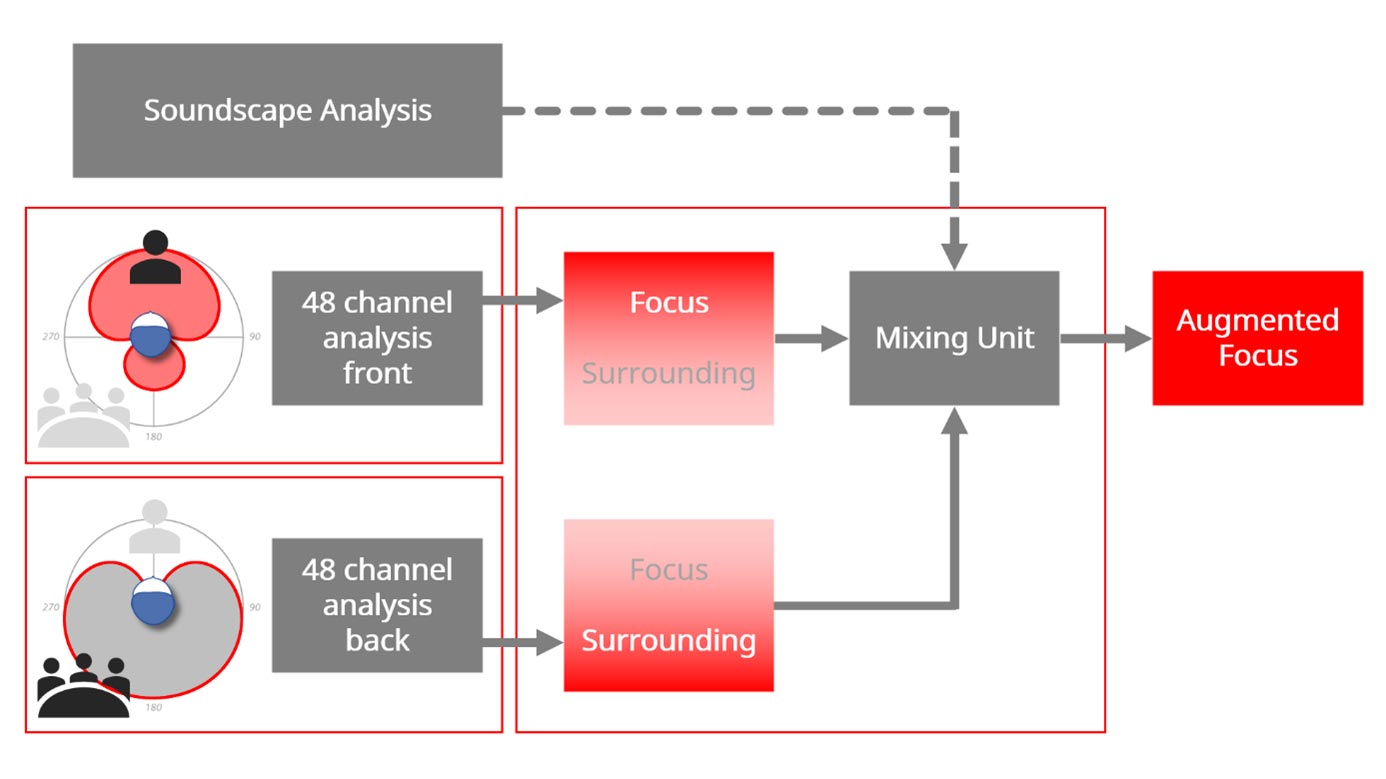
Figure 1. Schematic diagram showing the main Augmented Focus processing blocks. Beamformer technology is used to split incoming signals into two streams, which are processed separately. In this example, the speech coming from the front is detected and processed as a Focus stream, while the noise from behind is detected and processed as a Surrounding stream. The streams are mixed intelligently based on a soundscape analysis.
Following the independent processing of input sounds, the two streams are recombined in a mixing unit, which takes the information provided by the advanced Dynamic Soundscape Processing analysis into account. The Dynamic Soundscape Processing analysis was launched as part of the Xperience platform in 2019 and includes sound classification, motion sensor, signal-to-noise ratio estimation, Own Voice Processing (OVP), and classification of ambient modulations (see e.g. Froehlich et al., 2019a; Froehlich et al., 2019b; Froehlich et al., 2018). More detailed information about the Augmented Focus processing is provided by Best et al. (2021).
The separate processing of the Focus and Surrounding streams offers several significant wearer benefits. It allows a speech signal in the Focus stream to be processed without being affected by sounds in the Surrounding stream. Augmented Focus typically provides more linear processing for speech, which results in the speech being perceived as clearer, and thus, makes it prominently stand out from the background noise. Further, the split processing improves the perception of the background sounds by offering a fast and precise adjustment of the gain for sounds in the Surrounding stream. This improves the stability of the background noise, and accordingly, the wearer’s perception of the entire soundscape is enhanced.
All these benefits can be perceived by Signia AX wearers during everyday listening situations. Accordingly, we designed the survey to focus on ordinary real-world listening situations where these purported benefits are most likely to occur.
Methods
The survey approach was employed previously by Høydal et al. (2021). The approach involved asking a number of hearing care professionals (HCPs) in three different countries to fit a group of their existing hearing aid wearers with Signia AX. These wearers then acted as respondents in the survey. The wearers’ task was to evaluate the Signia AX in their everyday life and compare the experience and performance with that offered by their own hearing aids.
Respondents
This paper reports on data from 18 respondents, all from the US. They were between the ages of 28 and 91 years old (average: 74 years). All respondents were experienced hearing aid wearers, fitted bilaterally with hearing aids of various brands and models. The self-reported average age of their own hearing aids was four years.
Signia AX fittings
All respondents were fitted bilaterally with Pure Charge&Go AX RIC devices (with M-receivers). The ear coupling was determined by the HCP and based on each respondent’s hearing loss and their personal preferences. The fitting of the devices was completed in a routine manner, using the Signia AX First Fit rationale in Connexx 9.5. All devices were rechargeable, and respondents were able to charge their own devices. All respondents had the opportunity to use the Signia App, including the Signia Assistant, on their own smartphone during the survey period, but this was not mandatory.
Survey protocol
The protocol included one visit to the HCP clinic where the respondents were fitted with Signia AX and were asked to fill in an online questionnaire with some background questions (about age, gender, etc.), and questions about their experience with their own hearing aids. The respondents were then asked to use the Signia AX devices for two weeks. After two days, the HCPs were encouraged to contact the respondents to ensure none of them had experienced any noticeable problems with the new devices.
After two successive weeks of wearing Signia AX, the respondents received a link to a second questionnaire where they answered the same questions about their experience with Signia AX that they had answered for their own hearing aids. When the questionnaire was completed, the respondents were asked to switch back to their own hearing aids and wear them for a week, after which the received a link to a third questionnaire, asking for the third time the same survey questions. Respondents were then asked to switch to the Signia AX devices and use them for a week, before completing the fourth and final questionnaire. In addition to the same survey questions that appeared in the previous three questionnaires, the fourth and final questionnaire asked respondents to state their preference between Signia AX and their own hearing aids in different domains. The complete survey time flow is shown in Figure 2.

Figure 2. The time flow of the survey protocol, showing when the different hearing devices were used and evaluated by the survey respondents during the four-week survey period.
Questionnaires
All questionnaires were administered online and could be filled in using a smartphone, tablet or laptop, by following a link that was sent directly to the respondents via both email and text message.
The questionnaires included background questions (only first questionnaire), questions on satisfaction in different listening situations rated on a seven-point Likert-type scale going from “very unsatisfied” to “very satisfied,” a question about use time (hours per day), a question on whether the respondent would recommend the hearing aids to another person, select questions from the Speech, Spatial and Qualities of hearing questionnaire (SSQ; Gatehouse & Noble, 2004) rated on a scale from 0 to 10, and six questions on the preference between Signia AX and the respondents’ own hearing aids in different domains (only final questionnaire).
Results
In this paper, we only report on the preliminary data. A more comprehensive analysis will be conducted and reported when the full data set, including data from Germany and France, is available.
Satisfaction
The respondents were asked the following questions about their satisfaction with the given hearing devices in each of the four questionnaires:
- Overall, how satisfied are you with the hearing aids?
- How satisfied are you with the overall sound quality of the hearing aids?
- How satisfied are you with the hearing aids with respect to understanding speech, across all communication situations?
- How satisfied are you with the sound of your own voice when speaking with others with the hearing aids?
- How satisfied are you with how the hearing aids look when you wear them?
- How satisfied are you with the physical comfort of the hearing aids?
The satisfaction ratings reported below are the ratings made in questionnaires 3 (own hearing aids) and 4 (Signia AX), after respondents had worn both sets of devices and were fully acclimatized to Signia AX. Figure 3 shows the mean ratings of satisfaction provided by the respondents. In the plot, the seven-point Likert-type scale has been translated to a seven-point numeric scale from 1 (very unsatisfied) to 7 (very satisfied).
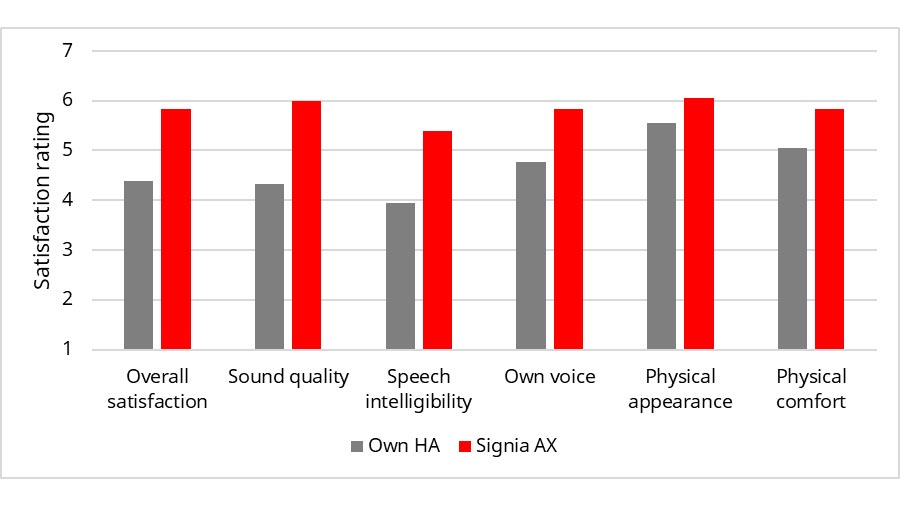
Figure 3. The mean ratings of satisfaction with Signia AX and own hearing aids, averaged across all participants. Both overall satisfaction with the devices and satisfaction within five specific domains were rated.
Figure 3 shows that the respondents rated Signia AX higher than their own hearing aids in all six domains. Even though respondents were largely satisfied with their own hearing aids, as indicated by mean ratings in the upper half of the scale, Signia AX was able to provide a consistent and noticeable improvement. The effect of Augmented Focus is a likely explanation for the higher levels of satisfaction to the questions about sound quality and speech intelligibility, whereas the higher satisfaction ratings with the respondents’ own voice can be attributed to the Own Voice Processing (OVP), a mainstay feature integrated into Signia AX.
Besides the audiological benefits leading to higher levels of satisfaction, the design of the Pure C&G AX devices used in the survey and the improved physical fit offered by the new EarWear 3.0 receivers, ear tips and sleeves also resulted in higher satisfaction ratings on the questions related to both physical appearance and physical comfort. The higher levels of overall satisfaction – and the clear-cut improvement compared to the respondents’ satisfaction with their own hearing aids – can be attributed to both the audiological and the form factor design advances of Signia AX.
Another way to look at the same survey data is to calculate the percentage of the respondents who expressed satisfaction, as indicated by providing one of the three highest ratings, i.e., “somewhat satisfied,” “satisfied” or “very satisfied.” These percentages are shown in Figure 4 for Signia AX and for the respondents’ own hearing aids, for all six questions that were rated.
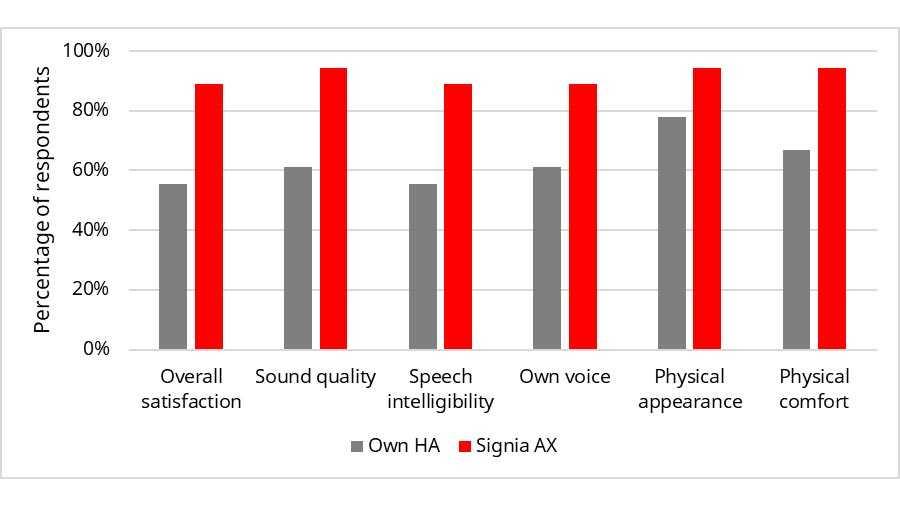
Figure 4. Percentage of respondents expressing satisfaction in the six questions for which the mean ratings were presented in Figure 3.
Overall, Figure 4 shows a similar trend: a marked increase in satisfaction associated with Signia AX. The level of satisfaction is generally high, and it is notable that 16 out of 18 respondents (89%) expressed an overall satisfaction with AX. The same share reported satisfaction with the perceived speech intelligibility and the sound of own voice, whereas 94% reported satisfaction with the perceived sound quality, the physical appearance and the physical comfort.
SSQ
The respondents answered select questions from the SSQ questionnaire. Each of the questions in the SSQ define a specific listening situation. Respondents were asked to rate their experience with the Signia AX and their own hearing aids on a scale from 0 to 10 (where higher ratings are better). For example, the first question said “You are talking with one other person and there is a TV on in the same room. Without turning the TV down, can you follow what the person you’re talking to says?” In this case, the end points of the rating scale were defined as “Not at all” (0) and “Perfectly” (10).
Figure 5 shows the mean ratings of respondents’ own hearing aids and Signia AX for the 13 SSQ questions included in the survey. Figure 5 includes brief descriptions of the listening situations queried by the SSQ. For some of the items in the SSQ, the mean rating is based on fewer than 18 (but always at least 14) responses, due to respondents using the N/A response option. They were asked to do so if they had not experienced the type of listening situation asked about. For some of the N/A responses, the COVID-19 restrictions may have been a main reason, not least for questions that dealt with social situations that rarely occurred during the pandemic.
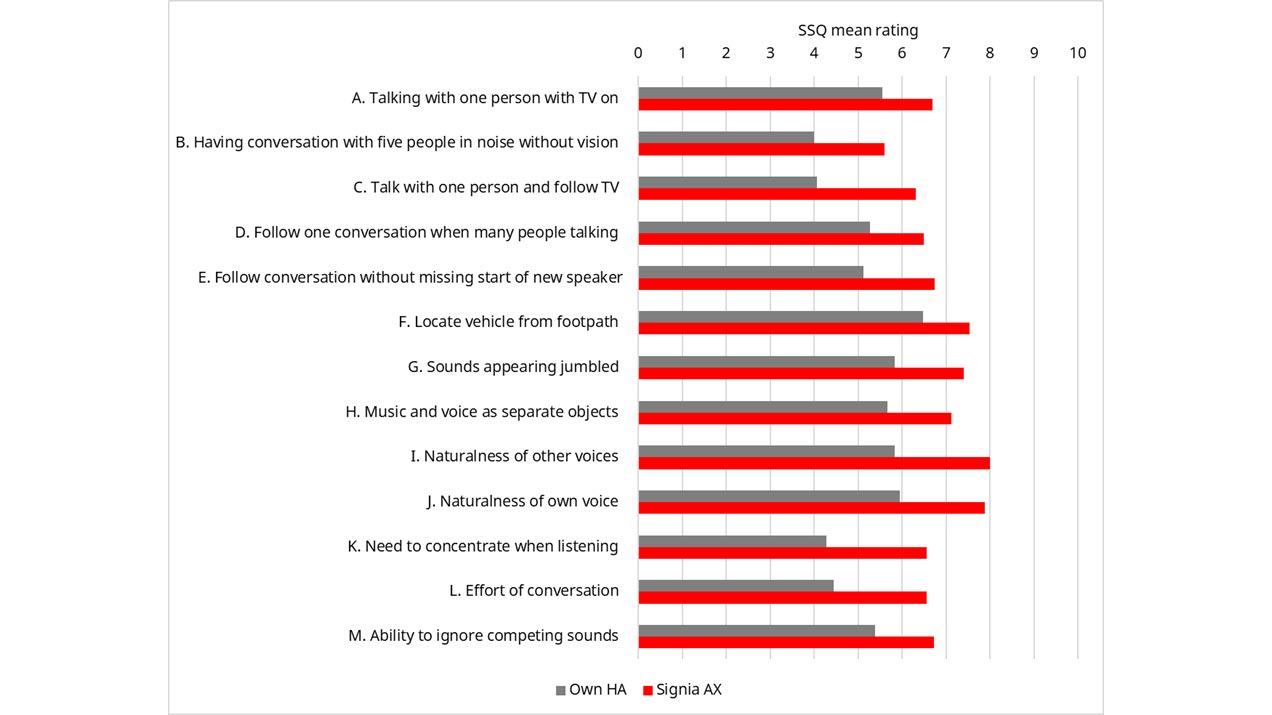
Figure 5. Mean ratings of the SSQ questions included in the survey, with short descriptions of the listening situations that were rated. A high rating always indicates better performance.
Figure 5 shows that respondents rated Signia AX higher than their own hearing aids across all 13 SSQ questions. In all cases, the mean difference exceeded one scale point, and for some questions, the difference even exceeded two scale points. Although these results reflect a strong trend in favor of Signia AX, the results should be interpreted with caution. There was a limited number of respondents in the sample and there is considerable variation across individual respondents. However, given the magnitude of the differences between Signia AX and their own hearing aids, this strong and consistent trend toward Signia AX is impressive.
Among the noteworthy observations in Figure 5 are the benefits provided by Signia AX in situations involving speech communication (items A, B, C, D and E). In these situations, Augmented Focus with its ability to process speech and surroundings separately is a likely central explanation for the improvements. Also, the Signia AX split processing is a likely explanation for the improved separation of sounds (items G and H), the improved sound quality of other voices (item I) and the improvements in listening effort-related domains (items K, L and M).
As it was the case in the satisfaction question about own voice, the corresponding SSQ item (J) also shows a clear improvement with Signia AX that can be directly linked to the effect of Signia’s OVP feature.
While the respondents’ SSQ ratings for Signia AX were higher than the ratings for their own hearing aids, it is notable that the mean ratings for Signia AX were somewhat below the SSQ’s scale maximum of 10. It is important to remember that average SSQ scores normally fall well below 10, even for normal-hearing individuals (Banh et al., 2012). For example, the item with the lowest mean rating (item B: having conversation with five people in noise without being able to see everyone else in the group) is typically perceived as quite difficult by most people, including those with normal hearing.
Preference
In the fourth and final questionnaire, the respondents were asked to state their preference between Signia AX and their own hearing aids for the following questions:
- In your experience, which hearing aids require the least listening effort in daily life?
- In your experience, which hearing aids provide the best speech understanding across all listening situations?
- In your experience, which hearing aids provide the most exciting listening experience in your daily life?
- In your experience, which hearing aids make your feel more energized (less tired/less strained) in your daily life?
- In your experience, which hearing aids make you feel more confident in your daily life?
- Overall, which hearing aids do you prefer?
A ‘forced choice’ approach was used in which the respondents had to choose between two response options: own hearing aids or Signia AX. The distribution of preferences among the respondents for each of the six questions is shown in Figure 6.
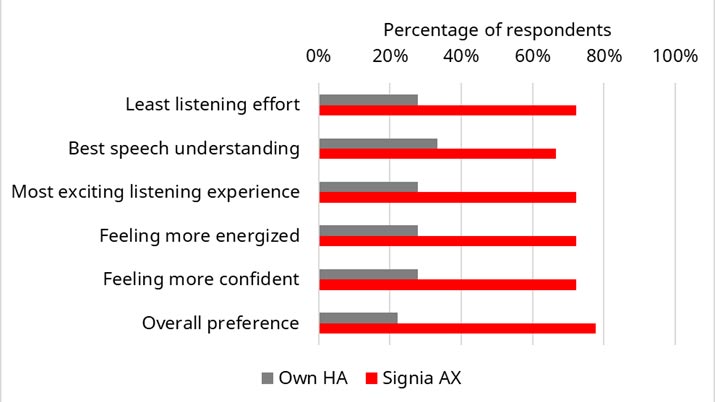
Figure 6. Percentage of respondents stating a preference for own hearing aids and Signia AX, respectively, for five specific domains as well as for overall preference.
Consistent with the absolute ratings reported above, the data in Figure 6 show a clear and consistent preference for Signia AX over own hearing aids. For the first five domains, the share of respondents preferring Signia AX varies between 67% and 72%, while 78% stated an overall preference for Signia AX.
Among the questions, respondents were asked which device provided the most “exciting listening experience.” Although this may seem like an unusual question, given the unique split processing of Augmented Focus, posing this question to respondents contributes to understanding its potential multifaceted, quality of life benefit. Additionally, respondents were asked which device made them feel more energized and confident. Results of these questions, illustrated in Figure 6, demonstrate a clear preference for Signia AX compared to the respondents’ own hearing aids. This finding suggests Signia AX not only affects the wearers’ listening experience in isolation, but positively affects other aspects of their quality of life.
Discussion
Preliminary results of this wearer survey indicate several outcomes that favor Signia AX and its Augmented Focus processing. Overall, this first tranche of survey data demonstrates several benefits that can be associated with the split processing of Augmented Focus, including clear and consistent benefits in several aspects of speech understanding. Further, the data indicate these improvements were observed in questions related to listening effort, sound quality and the ability to separate sounds.
In addition to the split processing of Augmented Focus, the new Signia AX platform has several other improvements that may contribute to an enhanced listening experience. For example, the faster binaural synchronization provides a smoother listening experience when switching between processing modes, and the extended input dynamic range improves the perception of loud sounds. These new feature enhancements have been integrated with several existing Signia features, such as OVP and motion sensor technology, and it is, of course, the combination of these features that contribute to the total listening experience evaluated in this survey.
The preliminary data reported in this paper were collected from a relatively small sample of respondents. While the survey data suggest substantially higher satisfaction and benefit ratings with Signia AX compared to the respondents’ own hearing aids, strong and detailed conclusions should not be drawn based on these data alone. Further data is being collected, in the US, Germany and France, and when the final data are available, they will provide a more precise and reliable result and will allow for more detailed analyses. The final data from this survey will be published in an upcoming article.
Summary
In an ongoing survey, the performance of Signia AX was evaluated in real-world listening and compared to the performance of the respondents’ own hearing aids. Preliminary data from the first 18 respondents who completed the survey indicate a considerably high level of satisfaction with Signia AX relative to their own devices. Furthermore, a clear improvement provided by Signia AX compared to the respondents’ own hearing aids was observed across a variety of questions included in the survey, with 78% of respondents stating an overall preference for Signia AX. Many of the Signia AX benefits observed in the survey data can be attributed to the Augmented Focus processing that allows separate and optimized processing of speech. The survey data collection is ongoing, and when the final data are available, more rigorous analyses can be done and stronger conclusions can be drawn. However, despite the small sample, the data presented in this paper clearly indicates the potential of Signia AX to make a difference for the wearers in their daily life.
Acknowledgements
We would like to thank all the hearing care professionals and all the hearing aid wearers who participated in this survey.
References
Banh J., Singh G. & Pichora-Fuller M.K. 2012. Age affects responses on the Speech, Spatial, and Qualities of Hearing Scale (SSQ) by adults with minimal audiometric loss. Journal of the American Academy of Audiology, 23(2), 81-91; quiz 139-140.
Best S., Serman M., Taylor B. & Høydal E.H. 2021. Augmented Focus. Signia Backgrounder. Retrieved from www.signia-library.com.
Bregman A.S. 1990. Auditory scene analysis: The perceptual organization of sound. Cambridge, MA: MIT Press.
Froehlich M., Branda E. & Freels K. 2019a. New Dimensions in Automatic Steering for Hearing Aids: Clinical and Real-world Findings. Hearing Review, 26(11), 32-37.
Froehlich M., Freels K. & Branda E. 2019b. Dynamic Soundscape Processing: Research Supporting Patient Benefit. AudiologyOnline, Article 26217. Retrieved from http://www.audiologyonline.com.
Froehlich M., Powers T.A., Branda E. & Weber J. 2018. Perception of Own Voice Wearing Hearing Aids: Why “Natural” is the New Normal. AudiologyOnline, Article 22822. Retrieved from www.audiologyonline.com.
Gatehouse S. & Noble W. 2004. The Speech, Spatial and Qualities of Hearing Scale (SSQ). International Journal of Audiology, 43(2), 85-99.
Høydal E.H., Jensen N.S., Hakvoort C. & Taylor B. 2021. Signal Processing Strategies that Improve Real-world Satisfaction in Key Listening Situations. Hearing Review, 28(3), 22-24.
Picou E.M. 2020. MarkeTrak 10 (MT10) Survey Results Demonstrate High Satisfaction with and Benefits from Hearing Aids. Seminars in Hearing, 41(1), 21-36.



